Gerrymandering in the United States
Gerrymandering is the practice of setting boundaries of electoral districts to favor specific political interests within legislative bodies, often resulting in districts with convoluted, winding boundaries rather than compact areas. Gerrymandering in the United States has been used to increase the power of a political party; the term "gerrymandering" was coined on review of Massachusetts's redistricting maps of 1812 set by Governor Elbridge Gerry, so named for its resemblance to a salamander.

In the United States, redistricting takes place in each state about every ten years, following the decennial census. This defines geographical boundaries, with each district within a state being geographically contiguous and having about the same number of state voters. The resulting map affects the elections of the state's members of the United States House of Representatives and the state legislative bodies. Redistricting has always been regarded as a political exercise, which in most states is controlled by state legislators and governor. When one party controls the state's legislative bodies and governor's office, it is in a strong position to gerrymander district boundaries to advantage their side and disadvantage their political opponents.[1] Since 2010, detailed maps and high-speed computing have facilitated gerrymandering by political parties in the redistricting process, in order to gain control of state legislation and Congressional representation, and to potentially maintain that control over several decades even against shifting political changes in a state's population.
Typical gerrymandering cases in the United States take the form of partisan gerrymandering, where the redistricting is aimed to favor one political party or weaken another; bipartisan gerrymandering that is used to protect incumbents by multiple political parties; and racial gerrymandering, aimed at weakening the power of minority voters.[2]
Through the 20th century and since then, the US Court system has deemed extreme cases of gerrymandering to be unconstitutional, but has struggled with how to define the types of gerrymandering and standards to be used to determine when redistricting maps are unconstitutional. The Supreme Court of the United States has affirmed in Miller v. Johnson (1995) that racial gerrymandering is a violation of constitutional rights and upheld decisions against redistricting purposely devised based on race. However, the Supreme Court has struggled as to when partisan gerrymandering occurs (Vieth v. Jubelirer (2004) and Gill v. Whitford (2018)), and in a landmark decision in 2019 in Rucho v. Common Cause, ultimately decided that questions of partisan gerrymandering represents a nonjusticiable political question that cannot be dealt with by the federal court system. This decision leaves it to states and Congress to develop remedies to challenge and prevent partisan gerrymandering. Some states have created independent redistricting commissions to reduce political drivers for redistricting.
| This article is part of a series on the |
| United States House of Representatives |
|---|
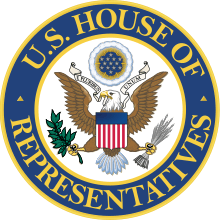 Great Seal of the United States House of Representatives |
|
History of the United States House of Representatives |
| Members |
|
|
| Politics and procedure |
|
| Places |
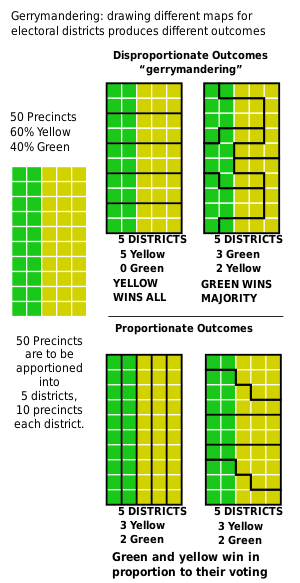
Partisan gerrymandering
Origins (1789–2000)
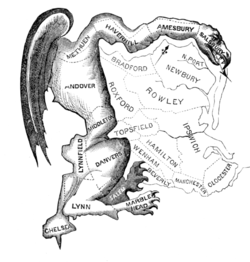
Partisan gerrymandering, which refers to redistricting that favors one political party, has a long tradition in the United States.
Starting from the William Cabell Rives in mid-19th century it is often stated that it precedes the 1789 election of the First U.S. Congress: namely, that while Patrick Henry and his Anti-Federalist allies were in control of the Virginia House of Delegates in 1788, they drew the boundaries of Virginia's 5th congressional district in an unsuccessful attempt to keep James Madison out of the U.S. House of Representatives.[3] However, in early 20th century it was revealed that this theory was based on incorrect claims by Madison and his allies, and recent historical research disproved it altogether.[4]
The word gerrymander (originally written "Gerry-mander") was used for the first time in the Boston Gazette (not to be confused with the Boston Gazette) on March 26, 1812 in reaction to a redrawing of Massachusetts state senate election districts under the then-governor Elbridge Gerry (1744–1814), who signed a bill that redistricted Massachusetts to benefit his Democratic-Republican Party. When mapped, one of the contorted districts to the north of Boston was said to resemble the shape of a salamander.[5]
The coiner of the term "gerrymander" may never be firmly established. Historians widely believe that the Federalist newspaper editors Nathan Hale, and Benjamin and John Russell were the instigators, but the historical record does not have definitive evidence as to who created or uttered the word for the first time.[6] Appearing with the term, and helping to spread and sustain its popularity, was a political cartoon depicting a strange animal with claws, wings and a dragon-like head satirizing the map of the odd-shaped district. This cartoon was most likely drawn by Elkanah Tisdale, an early 19th-century painter, designer, and engraver who was living in Boston at the time.[6] The word gerrymander was reprinted numerous times in Federalist newspapers in Massachusetts, New England, and nationwide during the remainder of 1812.
Gerrymandering soon began to be used to describe not only the original Massachusetts example, but also other cases of district-shape manipulation for partisan gain in other states. The first known use outside the immediate Boston area came in the Newburyport Herald of Massachusetts on March 31, and the first known use outside Massachusetts came in the Concord Gazette of New Hampshire on April 14, 1812. The first known use outside New England came in the New York Gazette & General Advertiser on May 19. What may be the first use of the term to describe the redistricting in another state (Maryland) occurred in the Federal Republican (Georgetown, Washington, DC) on October 12, 1812. There are at least 80 known citations of the word from March through December 1812 in American newspapers.[6]
The practice of gerrymandering the borders of new states continued past the Civil War and into the late 19th century. The Republican Party used its control of Congress to secure the admission of more states in territories friendly to their party. A notable example is the admission of Dakota Territory as two states instead of one. By the rules for representation in the Electoral College, each new state carried at least three electoral votes, regardless of its population.
From time to time, other names are given the "-mander" suffix to tie a particular effort to a particular politician or group. These include "Jerrymander" (a reference to California Governor Jerry Brown),[7] and "Perrymander" (a reference to Texas Governor Rick Perry).[8][9]
In the 1960s, a series of "one person, one vote" cases were decided by the Supreme Court, which resulted in a mandate of redistricting in response to the results of each census. Prior to these decisions, many states had stopped redrawing their districts. As a result of the periodic need to redistrict, political conflicts over redistricting have sharply increased.[10]
2000-2010
The potential to gerrymander a district map has been aided by advances in computing power and capabilities. Using geographic information system and census data as input, mapmakers can use computers to process through numerous potential map configurations to achieve desired results, including partisan gerrymandering.[11] Computers can assess voter preferences and use that to "pack" or "crack" votes into districts. Packing votes refers to concentrating voters in one voting district by redrawing congressional boundaries so that those in opposition of the party in charge of redistricting are placed into one larger district, therefore reducing the party's congressional representation. Cracking refers to diluting the voting power of opposition voters across many districts by redrawing congressional boundaries so that voting minority populations in each district are reduced, therefore lowering the chance of a district-oriented congressional takeover. Both techniques lead to what the Times describes as "wasted votes," which are votes that don't supply a party with any victory. These can either be a surplus of votes in one district for one party that are above the threshold needed to win, or any vote that has resulted in a loss.[12] A study done by the University of Delaware mentions situations in which an incumbent that is required to live in the district they represent can be "hijacked" or "kidnapped" into a neighboring district due to the redrawing of congressional boundaries, subsequently placing them in districts that are more difficult for them to win in.[13] Partisan gerrymandering oftentimes leads to benefits for a particular political party, or, in some cases, a race.
In Pennsylvania, the Republican-dominated state legislature used gerrymandering to help defeat Democratic representative Frank Mascara. Mascara was elected to Congress in 1994. In 2002, the Republican Party altered the boundaries of his original district so much that he was pitted against fellow Democratic candidate John Murtha in the election. The shape of Mascara's newly drawn district formed a finger that stopped at his street, encompassing his house, but not the spot where he parked his car. Murtha won the election in the newly formed district.[14]
State legislatures have used gerrymandering along racial or ethnic lines both to decrease and increase minority representation in state governments and congressional delegations. In the state of Ohio, a conversation between Republican officials was recorded that demonstrated that redistricting was being done to aid their political candidates. Furthermore, the discussions assessed race of voters as a factor in redistricting, because African-Americans had backed Democratic candidates. Republicans apparently removed approximately 13,000 African-American voters from the district of Jim Raussen, a Republican candidate for the House of Representatives, in an attempt to tip the scales in what was once a competitive district for Democratic candidates.[15]
International election observers from the Organization for Security and Co-operation in Europe Office for Democratic Institutions and Human Rights, who were invited to observe and report on the 2004 national elections, expressed criticism of the U.S. congressional redistricting process and made a recommendation that the procedures be reviewed to ensure genuine competitiveness of congressional election contests.[16]
2010-2020
In the lead-up to the 2010 United States elections, the Republican party initiated a program called REDMAP, the Redistricting Majority Project, which recognized that the party in control of state legislatures would have the ability to set their congressional and legislative district maps based on the pending 2010 United States Census in manner to assure that party's control over the next ten years. The Republican took significant gains from the 2010 elections across several states, and by 2011 and 2012, some of the new district maps showed Republican advantage through perceived partisan gerrymandering. This set the stage for several legal challenges from voters and groups in the court system, including several heard at the Supreme Court level.[17]
In 2015, Thomas Hofeller was hired by the Washington Free Beacon to analyze what would happen if political maps were drawn based on the population of U.S. citizens of voting age rather than on the total population. He concluded that doing so “would be advantageous to Republicans and non-Hispanic whites." Although the study was not published, it was discovered after his death in 2018.[18] Attorney General William P. Barr and Commerce Secretary Wilbur L. Ross Jr. have refused to cooperate with an investigation into why the Trump administration added a U.S. citizenship question to the 2020 census and specifically whether it seeks to benefit Republicans as suggested by Hofeller's study.[19]
Several state court rulings found partisan gerrymandering to be impermissible under state constitutions, and several state ballot measures passed in 2018 that require non-partisan commissions for the 2020 redistricting cycle.
Legality
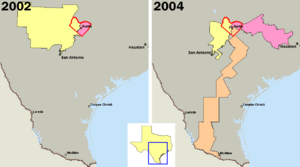

Whether a redistricting results in a partisan gerrymandering has been a frequent question put to the United States court system, but which the courts have generally avoided a strong ruling for fear of showing political bias towards either of the major parties.[21] The Supreme Court had ruled in Davis v. Bandemer (1986) that partisan gerrymandering violates the Equal Protection Clause and is a justiciable matter. However, in its decision, the Court could not agree on the appropriate constitutional standard against which legal claims of partisan gerrymandering should be evaluated. Writing for a plurality of the Court, Justice White said that partisan gerrymandering occurred when a redistricting plan was enacted with both the intent and the effect of discriminating against an identifiable political group. Justices Powell and Stevens said that partisan gerrymandering should be identified based on multiple factors, such as electoral district shape and adherence to local government boundaries. Justices O'Connor, Burger, and Rehnquist disagreed with the view that partisan gerrymandering claims were justiciable and would have held that such claims should not be recognized by courts.[22]:777–779 Lower courts found it difficult to apply Bandemer, and only in one subsequent case, Party of North Carolina v. Martin (1992),[23] did a lower court strike down a redistricting plan on partisan gerrymandering grounds.[22]:783
The Supreme Court revisited the concept of partisan gerrymandering claims in Vieth v. Jubelirer (2004).[24] While the Court upheld that partisan gerrymandering could be justiciable, the justices were divided in this specific case as no clear standard against which to evaluate partisan gerrymandering claims emerged. Writing for a plurality, Justice Scalia said that partisan gerrymandering claims were nonjusticiable. A majority of the court would continue to allow partisan gerrymandering claims to be considered justiciable, but those justices had divergent views on how such claims should be evaluated.[25] Justice Anthony Kennedy, in a concurrence with the plurality, offered that a manageable means to determine when partisan gerrymandering occurred could be developed, and challenged lower courts to find such means.[22]:819–821 The Court again upheld that partisan gerrymandering could be justiciable in League of United Latin American Citizens v. Perry (2006). While the specific case reached no conclusion of whether there was partisan gerrymandering, Justice John Paul Stevens's concurrence with the plurality added the notion of partisan symmetry, in that the electoral system should translate votes to representative seats with the same efficiency regardless of party.[26]
Opinions from Vieth and League, as well as the strong Republican advantage created by its REDMAP program, had led to a number of political scholars working alongside courts to develop such a method to determine if a district map was a justiciable partisan gerrymandering, as to prepare for the 2020 elections. Many early attempts failed to gain traction the court system, focusing more on trying to show how restricting maps were intended to favor one party or disfavor the other, or that the redistricting eschewed traditional redistricting approaches.[26] Around 2014, Nicholas Stephanopoulos and Eric McGhee developed the "efficiency gap", a means to measure the amount of wasted votes (votes either far in excess of what we necessary to secure a win for a party, or votes for a party that had little chase to win) within each district. The larger the gap of wasted votes between the two parties implied the more likely that the district maps supported a partisan gerrymandering, and with a sufficiently large gap it would be possible to sustain that gap indefinitely. While not perfect, having several potential flaws when geography of urban centers were considered, the efficiency gap was considered to be the first tool that met both Kennedy's and Stevens' suggestions.[27]
The first major legal test of the efficiency gap came into play for Gill v. Whitford (2016).[28] The District Court in the case used the efficiency gap statistic to evaluate the claim of partisan gerrymander in Wisconsin's legislative districts. In the 2012 election for the state legislature, the efficiency gap was 11.69% to 13% in favor of the Republicans. "Republicans in Wisconsin won 60 of the 99 Assembly seats, despite Democrats having a majority of the statewide vote."[29]
Moving the Harris's from a Democratic, Milwaukee district into a larger Republican area was part of a strategy known as 'packing and cracking.' Heavily Democratic Milwaukee voters were 'packed' together in fewer districts, while other sections of Milwaukee were 'cracked' and added to several Republican districts ... diluting that Democratic vote. The result? Three fewer Democrats in the state assembly representing the Milwaukee area.
— PBS NewsHour October 1, 2017
The disparity led to the federal lawsuit Gill v. Whitford, in which plaintiffs alleged that voting districts were gerrymandered unconstitutionally. The court found that the disparate treatment of Democratic and Republican voters violated the 1st and 14th amendments to the US Constitution.[30] The District Court's ruling was challenged and appealed to the Supreme Court of the United States, which in June 2017 agreed to hear oral arguments in the case in the 2017–2018 term of court.The case was then dismissed due to lack of standing for the plaintiffs with no decision on the merits being made.The case was then remanded for further proceedings to demonstrate standing.[31] While previous redistricting cases before the Supreme Court have involved the Equal Protection test, this case also centers on the applicability of the First Amendment freedom of association clause.[32][33]
Benisek v. Lamone was a separate partisan gerrymandering case heard by the Supreme Court in the 2017 term, this over perceived Democratic-favored redistricting of Maryland's 6th congressional district, with plaintiffs trying to get a stay on the use of the new district maps prior to the October 2018 general election. The Court did not give opinions on whether the redistricting was unconstitutional, but did establish that on the basis of Gill that the case should be reconsidered at the District Court.[34] The District Court did subsequently rule the redistricting was unconstitutional, and that decision was appealed again to the Supreme Court, who have agreed to hear the case in the 2018 term as Lamone v. Benisek.[35]
Yet another partisan redistricting case was heard by the Supreme Court during the 2018 term. Rucho v. Common Cause deals with Republican-favored gerrymandering in North Carolina. The District Court had ruled the redistricting was unconstitutional prior to Gill; an initial challenge brought to the Supreme Court resulted in an order for the District Court to re-evaluate their decision in light of Gill. The District Court, on rehearing, affirmed their previous decision. The state Republicans again sought for review by the Supreme Court, which is scheduled to issue its opinion by June 2018.[35]
The Pennsylvania Supreme court ruled that gerrymandering was unconstitutional, ruling that the districts drawn to favor Republicans violated "free and equal" Elections Clause of the Pennsylvanian constitution in League of Women Voters v. The Commonwealth of Pennsylvania[36] and redrew the districts after the state government failed to comply with the deadline in its order to redraw.[37] The Supreme Court denied to hear the challenge and allowed the Pennsylvania Supreme Court maps to remain in place.[38]
Similarly, Michigan's post-2010 redistricting has been challenged, and in April 2019, a federal court determined the Republican-led redistricting to be an unconstitutional partisan gerrymander, and orders the state to redraw districts in time for the 2020 election.[39] Within a week, a similar decision was arrived by a federal district court reviewing Ohio's district maps since 2012 and were declared unconstitutional as they were drawn by the Republican-majority lawmakers with "invidious partisan intent", and ordered the maps redrawn. The Republican-favored maps led Ohio's residents to vote for a statewide initiative that requires the new redistricting maps after the 2020 Census to have at least 50% approval from the minority party.[40] The Republican party sought an immediate challenge to the redistricting order, and by late May 2019, the Supreme Court ordered both the court-ordered redrawing to be put on hold until Republicans can prepare a complete petition, without commenting on the merits of the case otherwise. Additionally, observers to the Supreme Court recognized that the Court would be issuing its orders to the North Carolina and Maryland cases, which would likely affect how the Michigan and Ohio court orders would be interpreted.[41]
Rucho v. Common Cause and Lamone v. Benisek were decided on June 27, 2019, which, in the 5–4 decision, determined that judging partisan gerrymandering cases is outside of the remit of the federal court system due to the political questions involved. The majority opinion stated that extreme partisan gerrymandering is still unconstitutional, but it is up to Congress and state legislative bodies to find ways to restrict that, such as through the use of independent redistricting commissions.[42][43]
Bipartisan gerrymandering (favoring incumbents)
Bipartisan gerrymandering, where redistricting favors the incumbents in both the Democratic and Republican parties, became especially relevant in the 2000 redistricting process, which created some of the most non-competitive redistricting plans in American history.[22]:828 The Supreme Court held in Gaffney v. Cummings (1973) that bipartisan gerrymanders are constitutionally permissible under the Equal Protection Clause.[22]:828[44]
Racial gerrymandering
Racial makeup can be used as a means to create gerrymanders. There is overlap between racial and partisan gerrymandering, as minorities tend to favor Democratic candidates; the North Carolina redistricting in Rucho v. Common Cause was such a case dealing with both partisan and racial gerrymanders. However, racial gerrymanders can also be created without considerations of party lines.
Negative
"Negative racial gerrymandering" refers to a process in which district lines are drawn to prevent racial minorities from electing their preferred candidates.[45]:26 Between the Reconstruction Era and mid-20th century, white Southern Democrats effectively controlled redistricting throughout the Southern United States. In areas where some African-American and other minorities succeeded in registering, some states created districts that were gerrymandered to reduce the voting impact of minorities. Minorities were effectively deprived of their franchise into the 1960s. With the passage of the Voting Rights Act of 1965 and its subsequent amendments, redistricting to carve maps to intentionally diminish the power of voters who were in a racial or linguistic minority, was prohibited. The Voting Rights Act was amended by Congress in the 1980s, Congress to "make states redraw maps if they have a discriminatory effect."[12] In July, 2017, San Juan County, Utah was ordered to redraw its county commission and school board election districts again after "U.S. District Judge Robert Shelby ruled that they were unconstitutional." It was argued that the voice of Native Americans, who were in the majority, had been suppressed "when they are packed into gerrymandered districts."[46]
Affirmative
.gif)
While the Equal Protection Clause, along with Section 2 and Section 5 of the Voting Rights Act, prohibit jurisdictions from gerrymandering electoral districts to dilute the votes of racial groups, the Supreme Court has held that in some instances, the Equal Protection Clause prevents jurisdictions from drawing district lines to favor racial groups. The Supreme Court first recognized these "affirmative racial gerrymandering" claims in Shaw v. Reno (Shaw I) (1993),[47] holding that plaintiffs "may state a claim by alleging that [redistricting] legislation, though race neutral on its face, rationally cannot be understood as anything other than an effort to separate voters into different districts on the basis of race, and that the separation lacks sufficient justification". The Supreme Court reasoned that these claims were cognizable because relying on race in redistricting "reinforces racial stereotypes and threatens to undermine our system of representative democracy by signaling to elected officials that they represent a particular racial group rather than their constituency as a whole".[47]:649–650[48]:620 Later opinions characterized the type of unconstitutional harm created by racial gerrymandering as an "expressive harm",[22]:862 which law professors Richard Pildes and Richard Neimi have described as a harm "that results from the idea or attitudes expressed through a governmental action."[49]
Subsequent cases further defined the counters of racial gerrymandering claims and how those claims relate to the Voting Rights Act. In United States v. Hays (1996),[50] the Supreme Court held that only those persons who reside in a challenged district may bring a racial gerrymandering claim.[48]:623[50]:743–744 In Miller v. Johnson (1995),[51] the Supreme Court held that a redistricting plan must be subjected to strict scrutiny if the jurisdiction used race as the "predominant factor" in determining how to draw district lines. The court defined "predominance" as meaning that the jurisdiction gave more priority to racial considerations than to traditional redistricting principles such as "compactness, contiguity, [and] respect for political subdivisions or communities defined by actual shared interests."[48]:621[51]:916 In determining whether racial considerations predominated over traditional redistricting principles, courts may consider both direct and circumstantial evidence of the jurisdiction's intent in drawing the district lines, and irregularly-shaped districts constitute strong circumstantial evidence that the jurisdiction relied predominately on race.[22]:869 If a court concludes that racial considerations predominated, then a redistricting plan is considered a "racially gerrymandered" plan and must be subjected to strict scrutiny, meaning that the redistricting plan will be upheld as constitutional only if it is narrowly tailored to advance a compelling state interest. In Bush v. Vera (1996),[52]:983 the Supreme Court in a plurality opinion assumed that compliance with Section 2 or Section 5 of the Act constituted compelling interests, and lower courts have treated these two interests as the only compelling interests that may justify the creation of racially gerrymandered districts.[22]:877
In Hunt v. Cromartie (1999) and its follow-up case Easley v. Cromartie (2011), the Supreme Court approved a racially focused gerrymandering of a congressional district on the grounds that the definition was not pure racial gerrymandering but instead partisan gerrymandering, which is constitutionally permissible. With the increasing racial polarization of parties in the South in the U.S. as conservative whites move from the Democratic to the Republican Party, gerrymandering may become partisan and also achieve goals for ethnic representation.
Various examples of affirmative racial gerrymandering have emerged. When the state legislature considered representation for Arizona's Native American reservations, they thought each needed their own House member, because of historic conflicts between the Hopi and Navajo nations. Since the Hopi reservation is completely surrounded by the Navajo reservation, the legislature created an unusual district configuration for the 2nd congressional district that featured a fine filament along a river course several hundred miles in length to attach the Hopi reservation to the rest of the district; the arrangement lasted until 2013. The California state legislature created a congressional district (2003–2013) that extended over a narrow coastal strip for several miles. It ensured that a common community of interest will be represented, rather than having portions of the coastal areas be split up into districts extending into the interior, with domination by inland concerns.
In the case of League of United Latin American Citizens v. Perry, the United States Supreme Court upheld on June 28, 2006, most of a Texas congressional map suggested in 2003 by former United States House Majority Leader Tom DeLay, and enacted by the state of Texas.[53] The 7–2 decision allows state legislatures to redraw and gerrymander districts as often as they like (not just after the decennial census). In his dissenting opinion in LULAC v. Perry, Justice John Paul Stevens, joined by Justice Stephen Breyer, quoted Bill Ratliffe, former Texas lieutenant governor and member of the Texas state senate saying, "political gain for the Republicans was 110% the motivation for the plan," and argued that a plan whose "sole intent" was partisan could violate the Equal Protection Clause.[54] This was notable as previously Justice Stevens had joined Justice Breyer's opinion in Easley v. Cromartie, which held that explicitly partisan motivation for gerrymanders was permissible and a defense against claims of racial gerrymandering. Thus they may work to protect their political parties' standing and number of seats, so long as they do not harm racial and ethnic minority groups. A 5–4 majority declared one congressional district unconstitutional in the case because of harm to an ethnic minority.
Inclusion of prisons
Since the 1790 United States Census, the United States Census Bureau has counted prisoner populations as residents of the districts in which they are incarcerated, rather than in the same district as their previous pre-incarceration residence. In jurisdictions where incarcerated people cannot vote, moving boundaries around a prison can create a district out of what would otherwise be a population of voters which is too small. One extreme example is Waupun, Wisconsin, where two city council districts are made up of 61% and 76% incarcerated people, but as of 2019, neither elected representative has visited the local prisons.[55]
In 2018, the Census Bureau announced that it would retain the policy, asserting that the policy "is consistent with the concept of usual residence, as established by the Census Act of 1790," but also conceding assistance to states who wish "'to 'move' their prisoner population back to the prisoners' pre-incarceration addresses for redistricting and other purposes".[56] A number of states have since ordered their state governments to recognize incarcerated persons as residents of their pre-incarceration homes for the sake of legislative and congressional redistricting at all levels, including Maryland (2010), New York (2010) in time for the 2010 Census, and California (2011), Delaware (2010), Nevada (2019) and Washington State (2019), New Jersey (2020), and Colorado (2020)[57] in time for the 2020 Census. Colorado (2002), Michigan (1966), Tennessee (2016) and Virginia (2013) have passed laws restricting counties and municipalities from (or allowing counties and municipalities to avoid) prison-based redistricting, and Massachusetts passed a 2014 resolution requesting the Census Bureau to end the practice of counting prisoners in their incarceration districts.
Remedies
Various political and legal remedies have been used or proposed to diminish or prevent gerrymandering in the country.[22]
Neutral redistricting criteria
Various constitutional and statutory provisions may compel a court to strike down a gerrymandered redistricting plan. At the federal level, the Supreme Court has held that if a jurisdiction's redistricting plan violates the Equal Protection Clause or Voting Rights Act of 1965, a federal court must order the jurisdiction to propose a new redistricting plan that remedies the gerrymandering. If the jurisdiction fails to propose a new redistricting plan, or its proposed redistricting plan continues to violate the law, then the court itself must draw a redistricting plan that cures the violation and use its equitable powers to impose the plan on the jurisdiction.[22]:1058[58]:540
In the Supreme Court case of Karcher v. Daggett (1983),[59] a New Jersey redistricting plan was overturned when it was found to be unconstitutional by violating the constitutional principle of one person, one vote. Despite the state claiming its unequal redistricting was done to preserve minority voting power, the court found no evidence to support this and deemed the redistricting unconstitutional.[60]
At the state level, state courts may order or impose redistricting plans on jurisdictions where redistricting legislation prohibits gerrymandering. For example, in 2010 Florida adopted two state constitutional amendments that prohibit the Florida Legislature from drawing redistricting plans that favor or disfavor any political party or incumbent.[61] Ohio residents passed an initiative in 2018 that requires the redistricting maps to have at least 50% approval by the minority party in the legislature.[40]
Moon Duchin, a Tufts University professor, has proposed the use of metric geometry to measure gerrymandering for forensic purposes.[62]
Redistricting commissions
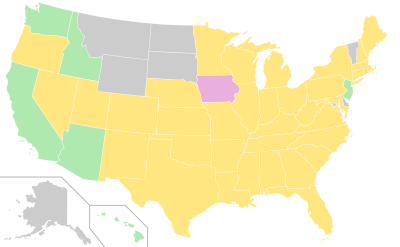
State legislatures control redistricting
Commissions control redistricting
Nonpartisan staff develop the maps, which are then voted on by the state legislature
No redistricting due to having only one congressional district
Some states have established non-partisan redistricting commissions with redistricting authority. Washington,[63] Arizona,[64] and California have created standing committees for redistricting following the 2010 census. However, it has been argued that the Californian standing committee has failed to end gerrymandering.[65] Rhode Island[66] and the New Jersey Redistricting Commission have developed ad hoc committees, but developed the past two decennial reapportionments tied to new census data.
The Arizona State Legislature challenged the constitutionality of a non-partisan commission, rather than the legislature, for redistricting. In Arizona State Legislature v. Arizona Independent Redistricting Commission (2015), the US Supreme Court upheld the constitutionality of non-partisan commissions.[67]
Alternative voting systems
The predominant voting system in the United States is a first-past-the-post system that uses single-member districts. Various alternative district-based voting systems that do not rely on redistricting, or rely on redistricting minimally, have been proposed that may mitigate against the ability to gerrymander. These systems typically involve a form of at-large elections or multimember districts. Examples of such systems include the single-transferable vote, cumulative voting, and limited voting.[68]
Proportional voting systems, such as those used in all but three European states, would bypass the problem altogether. In these systems, the party that gets, for example, 30 percent of the votes gets roughly 30 percent of the seats in the legislature. Although it is common for European states to have more than two parties, a sufficiently high election threshold can limit the number of parties elected. Some proportional voting systems have no districts or larger multimember districts and may break the strong constituency link, a cornerstone of current American politics, by eliminating the dependency of individual representatives on a concrete electorate.[69] However, systems like mixed-member proportional representation keep local single-member constituencies but balance their results with nationally- or regionally-elected representatives to reach party proportionality.
Effects
Gerrymandering and the environment
Gerrymandering has the ability to create numerous problems for the constituents impacted by the redistricting. A study done by the peer-reviewed Environmental Justice Journal analyzed how gerrymandering contributes to environmental racism. It revealed that partisan gerrymandering can often lead to adverse health complications for minority populations that live closer to United States superfund sites and additionally found that during redistricting periods, minority populations are "effectively gerrymandered out" of districts that tend to have fewer people of color in them and are farther away from toxic waste sites. This redistricting can be seen as a deliberate move to further marginalize minority populations and restrict them from gaining access to congressional representation and potentially fixing environmental hazards in their communities.[70]
Gerrymandering and the 2018 midterm elections
Gerrymandering was considered by many Democrats to be one of the biggest obstacles they came across during the 2018 U.S. midterm election. In early 2018, both the United States Supreme Court and the Pennsylvania Supreme Court determined that the Republican parties in North Carolina and Pennsylvania had committed unconstitutional partisan gerrymandering in the respective cases Cooper v. Harris and League of Women Voters of Pennsylvania v. Commonwealth of Pennsylvania. In the case of Pennsylvania, the map was reconfigured into an evenly split congressional delegation, which gave Democrats in Pennsylvania more congressional representation and subsequently aided the Democrats in flipping the U.S. House of Representatives. In contrast, North Carolina did not reconfigure the districts prior to the midterm elections, which ultimately gave Republicans there an edge during the election. Republicans in North Carolina acquired 51% of the vote, which subsequently garnered them about 75% of the available seats in congress.[71][72]
| State | % Vote D | % Vote R | % Seats D | % Seats R | Total Seats | Difference Between D | Difference Between R |
|---|---|---|---|---|---|---|---|
| North Carolina | 48.35% | 50.39% | 23.08% | 76.92% | 13 | −25.27% | 26.53% |
| Ohio | 47.27% | 52% | 25% | 75% | 16 | −22.27% | 23% |
Other factors affecting redistricting
At a federal level, gerrymandering has been blamed for a decrease in competitive elections, movement toward extreme party positions, and gridlock in Congress. Harry Enten of FiveThirtyEight argues that decreasing competition is partly due to gerrymandering, but even more so due to the population of the United States self-segregating by political ideology, which is seen in by-county voter registrations. Enten points to studies which find that factors other than gerrymandering account for over 75% of the increase in polarization in the past forty years, presumably due largely to changes among voters themselves. Because the Senate (which cannot be gerrymandered due to the fixed state borders) has been passing fewer bills but the House (which is subject to gerrymandering) has been passing more (comparing 1993–2002 to 2013–2016), Enten concludes gridlock is due to factors other than gerrymandering.[73]
Examples of gerrymandered US districts
.gif) |
North Carolina's 12th congressional district between 2003 and 2016 was an example of packing. The district has predominantly African-American residents who vote for Democrats.[74] |
| California's 23rd congressional district was an example of packing confined to a narrow strip of coast drawn from three large counties. The district shown was radically redrawn by California's non-partisan commission after the 2010 census. | |
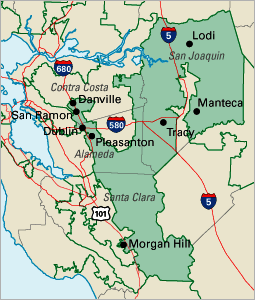 |
California's 11th congressional district featured long, strained projections and counter-projections of other districts, achieving mild but reliable packing. The district comprised a selection of people and communities favorable to the Republican Party. It was redrawn from the version shown after the 2010 census. |
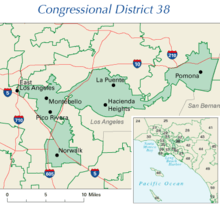 |
Bi-partisan incumbent gerrymandering produced California's 38th congressional district, home to Grace Napolitano, a Democrat, who ran unopposed in 2004. This district was redrawn by California's non-partisan commission after the 2010 census. |
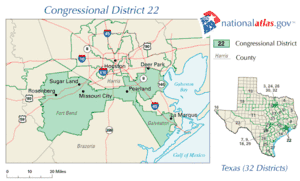 |
Texas's controversial 2003 partisan gerrymander produced Texas District 22 for former Rep. Tom DeLay, a Republican. A packed seat of Republicans based on past results of its many voting districts, it features a two necks and a counter-projection. |
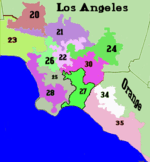 |
The odd shapes — distended projections and non-natural feature-based wiggly boundaries — of California Senate districts in southern California (2008) have led to complaints of gerrymandering. |
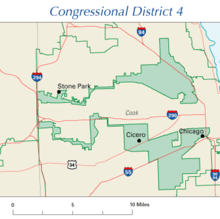 |
Illinois's 4th congressional district has the moniker "the earmuffs" and amounts to packing of two mainly Hispanic areas.[75] It has had in relative terms hairline contiguity along Interstate 294 and two necks at right angles, forming a very long neck between two areas, which was somewhat widened in 2013.[76] |
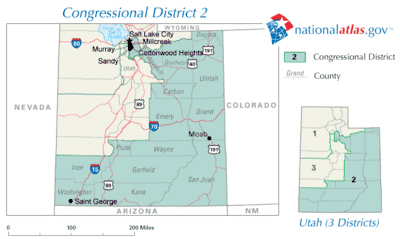 |
After the Democrat Jim Matheson was elected in 2000, the Utah legislature redrew the 2nd congressional district to favor future Republican majorities. The predominantly Democratic city of Salt Lake City was connected to predominantly Republican eastern and southern Utah through a thin sliver of land running through Utah County. Nevertheless, Matheson continued to be re-elected. In 2011, the legislature created new congressional districts that combined conservative rural areas with more urban areas to dilute Democratic votes. |
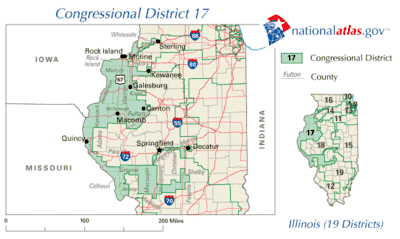 |
Illinois's 17th congressional district in the western portion of the state was gerrymandered: the major urban centers are anchored and Decatur is included, although nearly isolated from the main district. It was redrawn in 2013. |
.tif.png) Maryland's 3rd congressional district since 2013 |
Maryland's 3rd congressional district was listed in the top ten of the most gerrymandered districts in the United States by The Washington Post in 2014.[77] The district is drawn to favor Democratic candidates. Current MD-3 representative John Sarbanes has put forth the For the People Act of 2019 aimed at U.S. electoral reform to address partisan gerrymandering, voting rights and other issues.[78][79] |
.tif.png) North Carolina's 4th congressional district 2013–2017 |
North Carolina's 4th congressional district encompasses parts of Raleigh, Hillsborough, and the entirety of Chapel Hill. The district is considered to be one of the most gerrymandered districts in North Carolina and the United States as a whole.[77] The district was redrawn in 2017. |
See also
- California redistricting propositions
- Proposition 11 (2008)
- Proposition 20 (2010)
- Electoral geography
- Checkerboarding (land)
- Gerrymandering (film)
- Kilgarlin v. Martin
- Voter suppression
- United States congressional apportionment
- For the People Act of 2019
- Katie Fahey
- Thomas Hofeller
References
- Here are the most obscenely gerrymandered congressional districts in America
- "How racial gerrymandering deprives black people of political power". Retrieved December 13, 2018.
- Labunski, Richard. James Madison and the Struggle for the Bill of Rights, New York: Oxford University Press, 2006
- https://muse.jhu.edu/article/448116
- Griffith, Elmer (1907). The Rise and Development of the Gerrymander. Chicago: Scott, Foresman and Co. pp. 72–73. OCLC 45790508.
- Martis, Kenneth C. (2008). "The Original Gerrymander". Political Geography. 27 (4): 833–839. doi:10.1016/j.polgeo.2008.09.003.
- Thomas B. Hofeller, "The Looming Redistricting Reform; How will the Republican Party Fare?", Politico, 2011.
- David Wasserman (August 19, 2011). "'Perrymander': Redistricting Map That Rick Perry Signed Has Texas Hispanics Up in Arms". National Journal. Archived from the original on January 16, 2012.
- Mark Gersh (September 21, 2011). "Redistricting Journal: Showdown in Texas—reasons and implications for the House, and Hispanic vote". CBS News. Archived from the original on September 22, 2011. Retrieved May 14, 2012.
- McGhee, Eric (2020). "Partisan Gerrymandering and Political Science". Annual Review of Political Science. 23: 171–185. doi:10.1146/annurev-polisci-060118-045351.
- Ellenburg, Jordan (October 6, 2017). "How Computers Turned Gerrymandering Into a Science". The New York Times. Retrieved May 6, 2019.
- Bazelon, Emily (August 29, 2017). "The New Front in the Gerrymandering Wars: Democracy vs. Math". The New York Times. Retrieved October 1, 2017.
- Mackenzie, John (August 29, 2017). "Gerrymandering and Legislator Efficiency" (PDF). University of Delaware. Archived from the original (PDF) on January 11, 2019. Retrieved November 30, 2018.
- Thomas Lloyd Brunell (2008). Redistricting and Representation: Why Competitive Elections Are Bad for America. Psychology Press. p. 69. ISBN 9780415964524. Retrieved July 25, 2012.
- "Republican Party Politics (Part II)". WCPO. April 29, 2002. Archived from the original on May 20, 2002.
- "XI" (PDF). Retrieved August 5, 2009.
- Newkirk II, Vann (October 28, 2017). "How Redistricting Became a Technological Arms Race". The Atlantic. Retrieved May 6, 2019.
- Wines, Michael (May 30, 2019). "Deceased G.O.P. Strategist's Hard Drives Reveal New Details on the Census Citizenship Question". The New York Times. ISSN 0362-4331. Retrieved June 12, 2019.
- Davis, Julie Hirschfeld; Savage, Charlie (June 12, 2019). "Trump Asserts Executive Privilege on 2020 Census Documents". The New York Times. ISSN 0362-4331. Retrieved June 12, 2019.
- Wasserman, Dave; Flinn, Ally. "2018 House Popular Vote Tracker". Cook Political Report. Retrieved January 2, 2019.
- Graham, David (January 23, 2018). "Has the Tide Turned Against Partisan Gerrymandering?". The Atlantic. Retrieved April 29, 2019.
- Issacharoff, Samuel; Karlan, Pamela S.; Pildes, Richard H. (2012). The Law of Democracy: Legal Structure of the Political Process (4th ed.). Foundation Press. ISBN 978-1-59941-935-0.
- Party of North Carolina v. Martin, 980 F.2d 943 (4th Cir. 1992)
- Vieth v. Jubelirer, 541 U.S. 267 (2004)
- Engstrom, Richard. 2006. "Reapportionment." Federalism in America: An Encyclopedia.
- Stephanopoulos, Nicholas (July 2, 2014). "Here's How We Can End Gerrymandering Once and for All". The New Republic. Retrieved April 29, 2019.
- Kean, Sam (January 26, 2018). "The Flaw in America's 'Holy Grail' Against Gerrymandering". The Atlantic. Retrieved April 29, 2019.
- Whitford v Gill decision
- Weber, Sam; Fong, Laura (October 1, 2017). "Supreme Court to hear case testing the limits of partisan gerrymandering". PBS NewsHour. Retrieved October 1, 2017.
- Wines, Michael (November 21, 2016). "Judges Find Wisconsin Redistricting Unfairly Favored Republicans". The New York Times. Archived from the original on November 22, 2016. Retrieved February 25, 2020.CS1 maint: unfit url (link)
- Liptak, Adam (June 19, 2017). "Justices to Hear Major Challenge to Partisan Gerrymandering". The New York Times. Archived from the original on June 19, 2017. Retrieved February 25, 2020.CS1 maint: unfit url (link)
- Grofman, Bernard (January 31, 2017). "The Supreme Court will examine partisan gerrymandering in 2017. That could change the voting map". The Washington Post. Retrieved June 19, 2017.
- Prokop, Andrew (June 18, 2018). "The Supreme Court still won't crack down on partisan gerrymandering — yet, at least". Vox. Retrieved December 19, 2018.
- de Vogue, Ariane (June 18, 2018). "Supreme Court sidesteps partisan gerrymandering cases, let maps stand for now". CNN. Retrieved June 18, 2018.
- Liptak, Adam (January 4, 2019). "Supreme Court Takes Up New Cases on Partisan Gerrymandering". The New York Times. Archived from the original on January 7, 2019. Retrieved February 25, 2020.CS1 maint: unfit url (link)
- Lezarski, Lindsay (February 7, 2018). "Pa. Supreme Court details violation of voter rights in full opinion striking down congressional map". Philadelphia: WHYY Radio. Retrieved December 19, 2018.
- Bycoffe, Aaron (February 20, 2018). "Pennsylvania's New Map Helps Democrats. But It's Not A Democratic Gerrymander". Retrieved December 19, 2018.
- Liptak, Adam (March 19, 2018). "Supreme Court Won't Block New Pennsylvania Voting Maps". The New York Times. Retrieved May 6, 2019.
- Wines, Michael (April 25, 2019). "Judges Rule Michigan Congressional Districts Are Unconstitutionally Gerrymandered". The New York Times. Retrieved May 24, 2019.
- Gabriel, Trip; Wines, Michael (May 3, 2019). "Ohio Congressional Map Is Illegal Gerrymander, Federal Court Rules". The New York Times. Retrieved May 6, 2019.
- Grogorian, Deborah (May 24, 2019). "Supreme Court temporarily blocks rulings requiring new voting maps for Ohio and Michigan". NBC News. Retrieved May 24, 2019.
- Liptak, Adam (June 27, 2019). "Supreme Court Says Constitution Does Not Bar Partisan Gerrymandering". The New York Times. Retrieved June 27, 2019.
- "US supreme court declines to block partisan gerrymandering".
- Gaffney v. Cummings, 412 U.S. 735 (1973)
- Whitby, Kenny J. (December 21, 2000). The Color of Representation: Congressional Behavior and Black Interests. University of Michigan Press. ISBN 978-0472087020.
- Price, Michelle L. (July 20, 2017). "US Judge: Utah county election maps must be redrawn again". Metro News. Salt Lake City.
- Shaw v. Reno (Shaw I), 509 U.S. 630 (1993)
- Ebaugh, Nelson (1997). "Refining the Racial Gerrymandering Claim: Bush v. Vera". Tulsa Law Journal. 33 (2). Retrieved December 30, 2013.
- Pildes, Richard; Niemi, Richard (1993). "Expressive Harms, "Bizarre Districts," and Voting Rights: Evaluation Election-District Appearances after Shaw v. Reno". Michigan Law Review. 92 (3): 483–587. doi:10.2307/1289795. JSTOR 1289795.
- United States v. Hays, 515 U.S. 737 (U.S. 1995)
- Miller v. Johnson, 515 U.S. 900 (1995).
- Bush v. Vera 517 U.S. 952 (1996).
- "High court upholds most of Texas redistricting map". CNN. Associated Press. June 28, 2006.
- Calidas, Douglass (2008). "Hindsight Is 20/20: Revisiting the Reapportionment Cases to Gain Perspective on Partisan Gerrymanders". Duke Law Journal. 57 (5): 1413–1447. JSTOR 40040622.
- 'Your Body Being Used': Where Prisoners Who Can't Vote Fill Voting Districts
- Final 2020 Census Residence Criteria and Residence Situations
- Singer, Daliah (April 14, 2020). "Colorado Is the Eighth State To End Prison-Based Gerrymandering". 5280. Retrieved April 20, 2020.
- Wise v. Lipscomb, 437 U.S. 535(1978)
- Karcher v. Daggett, 462 U.S. 725 (1983)
- "Karcher v. Daggett – 462 U.S. 725 (1983)". Justia: US Supreme Court Center.
- "Election 2010: Palm Beach County & Florida Voting, Candidates, Endorsements | The Palm Beach Post". Projects.palmbeachpost.com. Archived from the original on December 8, 2010. Retrieved December 19, 2010.
- "Meet the Math Professor Who's Fighting Gerrymandering With Geometry". The Chronicle of Higher Education. February 22, 2017. Retrieved February 23, 2017.
- Washington State Redistricting Commission "Washington State Redistricting Commission". Redistricting.wa.gov. Retrieved August 5, 2009.
- Arizona Independent Redistricting Commission "Arizona Independent Redistricting Commission". Azredistricting.org. Retrieved August 5, 2009.
- "How Democrats Fooled California's Redistricting Commission". December 22, 2011.
- Rhode Island Reapportionment Commission Archived October 18, 2007.
- 576 U.S. ___, June 2015 (link to slip opinion), retrieved 2015-07-05.
- See generally Mulroy, Steven J. (1998). "The Way Out: A Legal Standard for Imposing Alternative Electoral Systems as Voting Rights Remedies". Harvard Civil Rights-Civil Liberties Law Review. 33. SSRN 1907880.
- "Advantages and disadvantages of List PR". www.aceproject.org ACE Project.
- Kramar, David (February 1, 2018). "A Spatially Informed Analysis of Environmental Justice: Analyzing the Effects of Gerrymandering and the Proximity of Minority Populations to U.S. Superfund Sites". Environmental Justice Journal. doi:10.1089/env.2017.0031.
- Lieb, David (November 17, 2018). "Midterm Elections Show How Gerrymandering is Difficult to Overcome". U.S. News & World Report. Archived from the original on November 20, 2018. Retrieved December 1, 2018.
- Ingraham, Christopher (November 9, 2018). "One state fixed its gerrymandered districts, the other didn't. Here's how the election played out in both". The Washington Post. Retrieved December 2, 2018.
- Enten, Harry (January 26, 2018). "Ending Gerrymandering Won't Fix What Ails America". FiveThirtyEight. Retrieved December 2, 2018.
- Blau, Max (October 19, 2016). "Drawing the line on the most gerrymandered district in America". the Guardian. Retrieved April 12, 2018.
- Aaron Blake (July 27, 2011). "Name that district! (Gerrymandering edition)". Washington Post. Retrieved July 28, 2011.
- The Economist (April 25, 2002). "How to rig an election".
- Ingraham, Christopher (May 15, 2014). "America's most gerrymandered congressional districts". Washington Post. ISSN 0190-8286. Retrieved March 29, 2018.
- Sarbanes, John (January 3, 2019). "H.R.1 – 116th Congress (2019–2020): To expand Americans' access to the ballot box, reduce the influence of big money in politics, and strengthen ethics rules for public servants, and for other purposes". www.congress.gov. Archived from the original on January 7, 2019. Retrieved January 6, 2019.
- 116th Congress (2019) (January 3, 2019). "H.R. 1 (116th)". Legislation. GovTrack.us. Retrieved March 7, 2019.
For the People Act of 2019
Further reading
- David Daley (2016). Ratf**ked: Why Your Vote Doesn't Count. Liveright. ISBN 978-1631491627.
- David Daley (2020). Unrigged: How Americans Are Battling Back to Save Democracy. Liveright. ISBN 978-1631495755.
External links
| Library resources about Gerrymandering in the United States |

General
- Polk, James. "Why your vote for Congress might not matter." CNN. Friday November 18, 2011.
- Understanding Congressional Gerrymandering: 'It's Moneyball Applied To Politics'. Interview with Ratf**ked author David Daley. NPR, June 15, 2016.
- This is actually what America would look like without gerrymandering, Washington Post
- Dickson v. Rucho – SCOTUSBlog profile; Brennan Center for Justice profile – North Carolina redistricting litigation
- Gerrymandering: Why Your Vote Doesn't Count, an article from Mother Jones Magazine
- The Gerrymandering Project – FiveThirtyEight
Simulations
- Gerryminder – An online redistricting simulation.
- Redistricting The Nation uses GIS and web technology to interactively explore redistricting
- The Redistricting Game – Where Do You Draw the Lines – a simulation of how redistricting works, developed by USC Game Innovation Lab of the USC School of Cinematic Arts Interactive Media Division.
- The Atlas Of Redistricting – maps drawn by various critera
- Impartial Automatic Redistricting – maps optimized for compactness and equal population only, based on 2010 census
- Splitline districtings of all 50 states + DC + PR